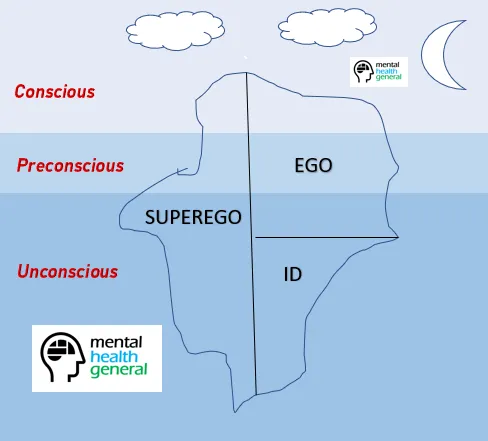Sigmund Freud’s Theory on Personality is considered to be one of his biggest contributions to psychology. Freud believed that the personality was split into three connected areas – the superego, the ego and the id.
In this article, we explore the “ego” section of Freud’s theory, and look at how it impacts mental health. For information on how the different parts of the personality compare, you can see our overview article here.
Embed from Getty ImagesFreud’s Theory of Personality
Freud’s theory of personality is based on the idea that there are three components of personality – the id, the Ego, and the Superego. They link to what Freud calls the conscious, unconscious and preconscious mind.
Freud believes that the id is the part of our personality that aims to satisfy basic needs; the superego is “the parent in our head” that looks out for our best interests; and the ego is the part of our personality that balances out the urges from the id and the superego.
Freud likened personality to an iceberg; an individual can only see a small piece of personality (i.e. the tip of the iceberg above the water), with most hidden away from view (like the iceberg).
The tip of the iceberg refers to what a person is aware of, and the forefront of the mind – as they are aware, it is considered to be the “conscious mind“. But under the water, there is an “unconscious mind” – where hidden thoughts, memories, feelings and desires are present [1].

What is the “ego”?
One may wonder how the mind makes someone avoid something. Freud suggested that this can be explained by the ego. The ego has the task of organising our thoughts to make our mind process learning in a coherent fashion.
In doing this, it is able to resolve any problems facing the id – such as whether or not to engage in a certain behaviour. Freud suggests that the ego steps in to help a person weigh up the positives and negatives of any given situation – and think about the consequences of certain actions.
Therefore, the role of the ego is to help stabilise an individual’s thoughts to the extent where they can make sensible decisions. Part of the ego however tries to impose high standards or desires into our behaviour – which falls into the superego.
Examining the ego
Clearly, the ego is crucial to our everyday functioning, and arguably protects us from death. The ego usually develops in the first three years of life. By mediating between the superego and the id, it ensures a person behaves and acts in a way that is in line with moral and societal norms.
For instance, if a person becomes irritated by someone, the ego stops the person from angrily confronting the person – as the ego knows this response would not be in line with expected behaviour. The ego operates in the conscious, preconscious, and unconscious mind.
Freud is known for likening the relationship of the id and the ego to a horse and rider. The horse (the id) is a strong force that is responsible for providing the powerful movement. The rider (the ego), is then the guiding force that manages to steer the horse (the id) towards the relevant goal.
But this isn’t always successfully done. The horse (the id) may have a mind of its own – one that is too powerful for its rider (the ego) to resist. This will often result in harm, as the urges of the id become too strong for the rationality of the ego to overcome.
The measures put in place by the ego to try and ensure this doesn’t happen are known as defence mechanisms. An example of this would be repression – where the person keeps certain thoughts, feelings, impulses or urges out of their conscious awareness.
The link to mental health
According to Freud, mental disturbance arises when the ego isn’t able to maintain its control of the id and the superego. Perhaps their impulses become too strong, and they engage in harmful behaviour.
Freud’s theory states that this disparity between the three states is often causes by trauma from early childhood. This trauma can then have a very bad effect on a person’s development, resulting in ill mental health.
In modern-day mental health, these ideas are taken into account in psychoanalysis-inspired talking therapies like Psychoanalytical Psychotherapy and Psychodynamic Psychotherapy.
Summary
While Freud’s theory of personality may not be universally popular, it still continues to impact the field of mental health. Many psychologists continue to use his ideas on personality.
We also have articles on the other two parts of Freud’s personality theory – the id and the Superego. Additionally, you can see more about Freud by seeing our list of articles about Freud here.
See Also
- Overview of Sigmund Freud and His Theories
- Freud’s Theory of the Id, the Ego and the Superego
- Freud’s Theory of the Id and Mental Health
- Freud’s Theory of the Ego and Mental Health
- Freud’s Theory of the Superego and Mental Health
- Explaining The Two Parts of the Superego According to Freud
Disclaimer
This website should be used purely for informational purposes, and does not intend to, nor should it ever, be used as a replacement for professional medical advice.
We strive to keep all of our pages updated, and ensure that our website is full of factual and in-depth information. However, we encourage you to browse this website with care.
As a reminder, this website and all content within it cannot and should not replace the advice of a trained medical professional. You can read our full disclaimer at this link.
Helplines
If you are struggling with your mental health, help is available. With the right support and treatment, you can make a recovery. For information on helplines, or if you are in a state of crisis, please visit our crisis page by clicking on the relevant link for your geographical location (United Kingdom), (United States), (International). You can also see how to get mental health treatment and the process involved by clicking this link.
References
[1] Freud, S., & Hall, G. S. (1920). A general introduction to psychoanalysis. Boni and Liveright: New York.



































